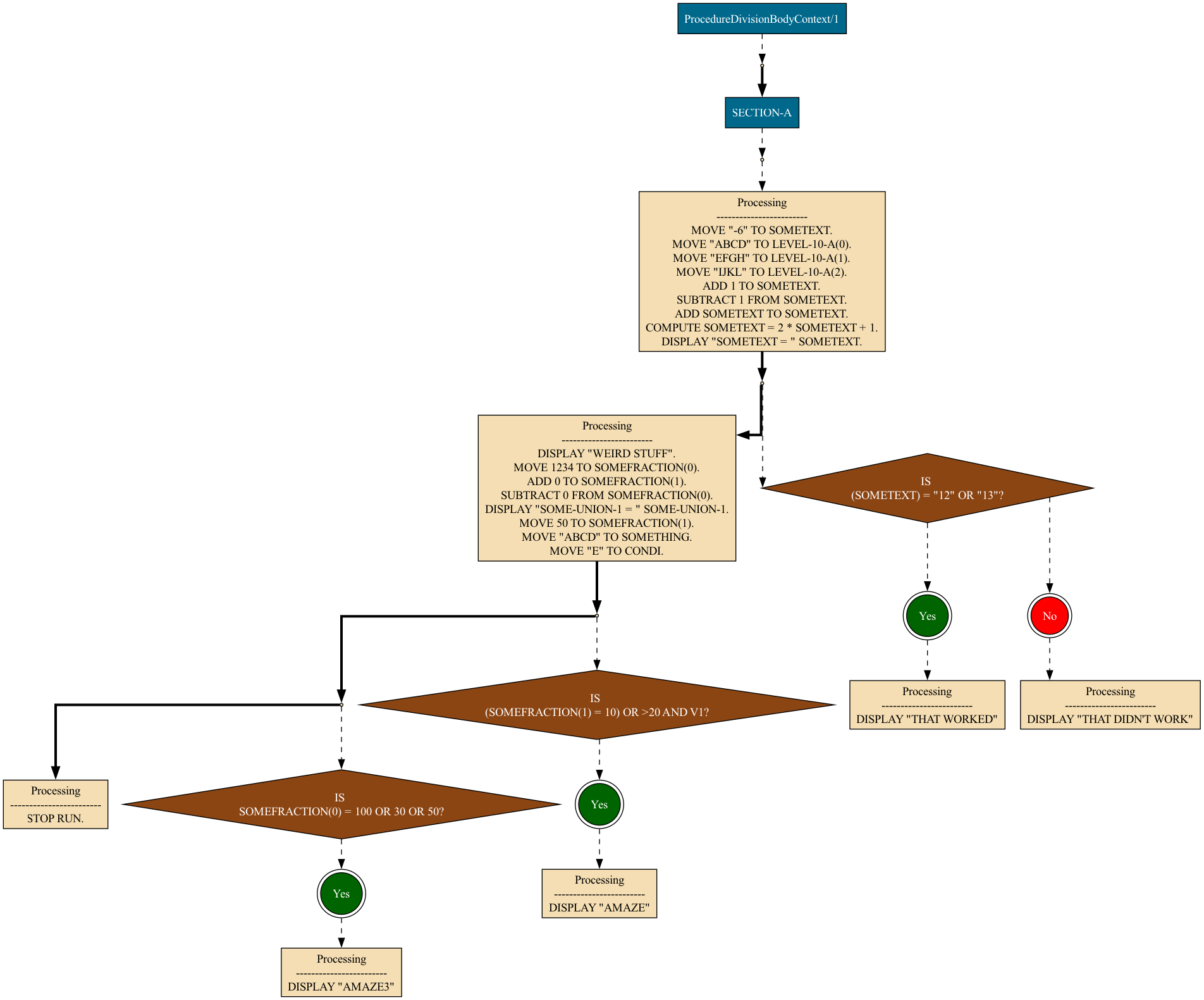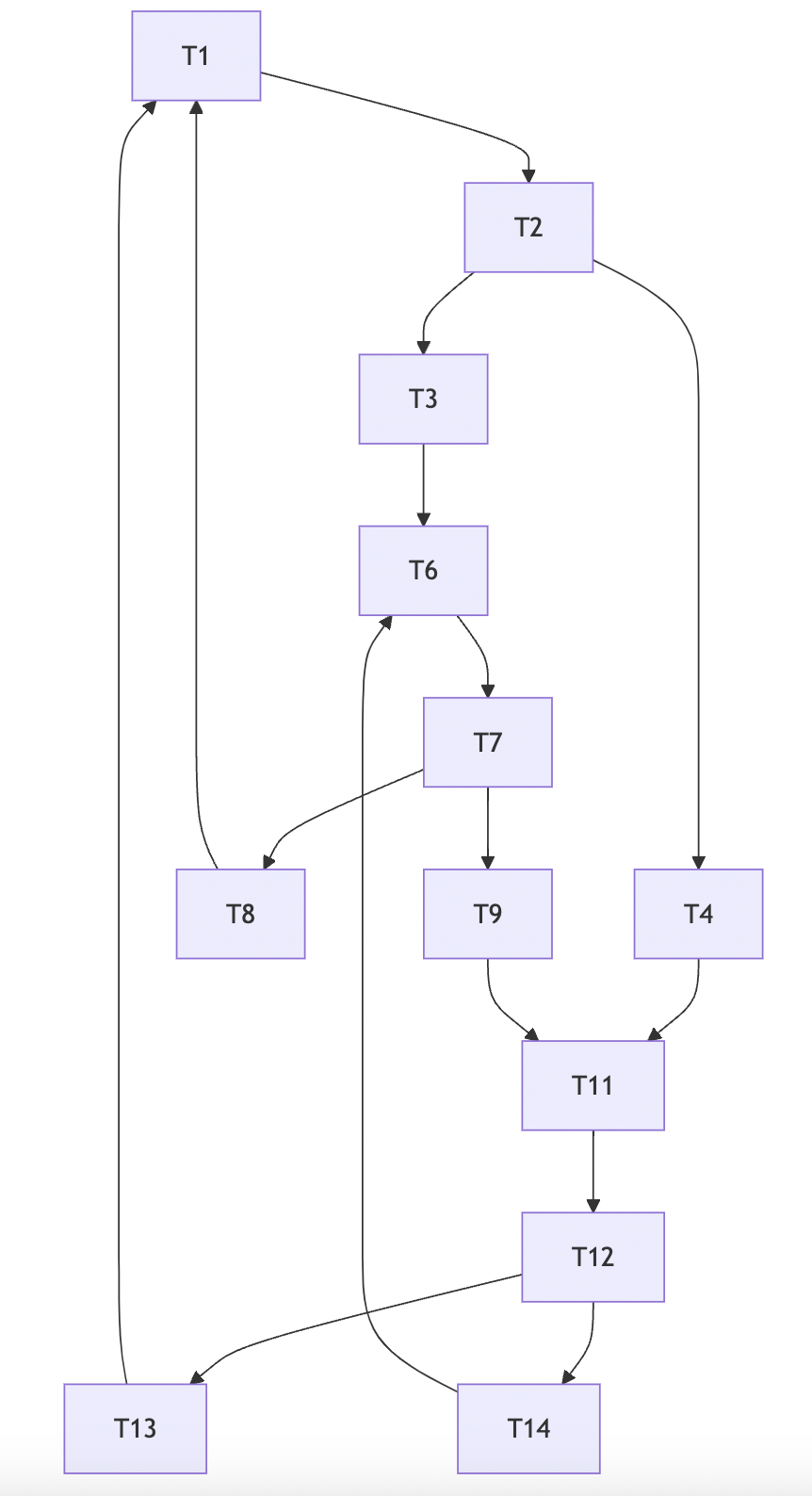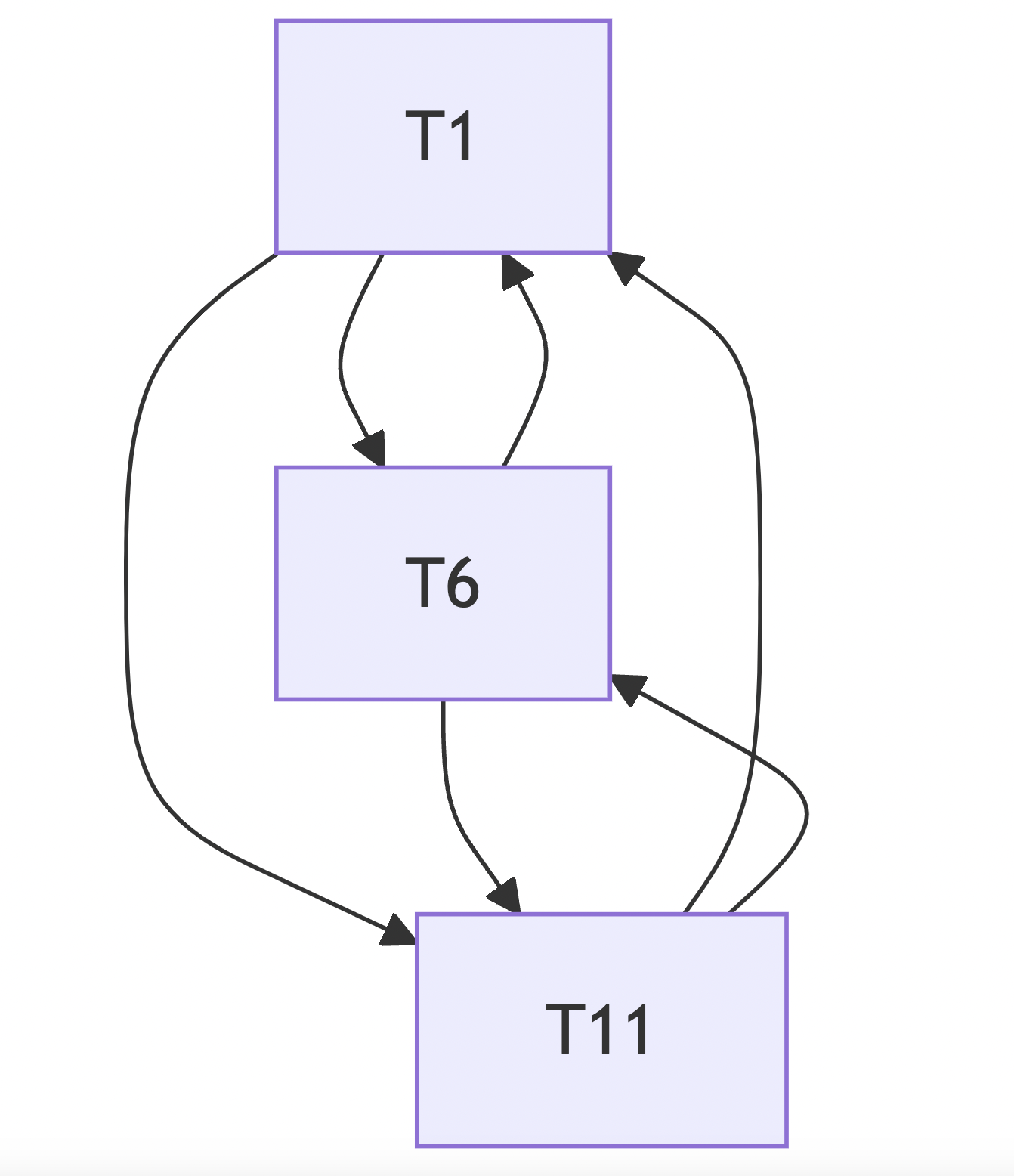Total Internal Reflection
Technology and Art
Code
Contact
Experiments in Reverse Engineering COBOL codebases
This post has not been written or edited by AI.
We will be talking about techniques in abstract, but will refer to concrete implementations in Cobol-REKT as needed.
Contents
- Introduction
- Parser
- Control Flow Graph (early version)
- Intermediate representation
- Translation into Syntax Tree
- Translation into Control Flowgraph
- Identifying Procedural Structures
- Interpretation
- Types of interpretation
- Control Flow Analysis
- What is reducibility?
- Tests for reducibility
- Dominator analysis
- Identifying irreducible regions
- Strongly connected components analysis
- DJ Graphs
- Future work: Controlled Node Splitting
- Semantics-preserving tree transformations
- Eliminating GOTOs
- Replicating COBOL’s record-based layout system
- References
Introduction
The source code for all of this work is based on Cobol-REKT.
Parser
The parser is the easier part, if only because I reused what was already available. The COBOL Language Support extension contains an ANTLR grammar which works. Note that it has been en
Control Flow Graph (early version)
A very naive version of a flowgraph can be built which is still tied to COBOL constructs. The nodes in this flowgraph represent native COBOL constructs. These nodes were originally designed to represent COBOL code as visual flowcharts, like below:

These nodes did not necessarily represent control flow very accurately, because of the following:
- There were always straight-line causal connections between every COBOL sentence. This included statements which unambiguously jumped to other sections/paragraphs of the program. This is because se
The syntax tree is also used for the following purposes:
- Building high-level flowgraph for further input into the intermediate representation
- Building symbol table with appropriate types
- Interpreting using a tree-walk interpreter
- External program dependency tracing
Intermediate representation
Translation into Syntax Tree
A more language-agnostic way of representing control flows (as well as syntax), is to decompose all COBOL-specific constructs into some simple intermediate representation which is more or less well-supported in most structured programming languages. Examples of such constructs would be:
IF...THEN...ELSESETLOOP(can represent normal loops,WHILE, andDO...WHILEconstructs)
The LOOP semantic provides a nice way to encapsulate the semantics of different kinds of loops:
WHILE-like constructs only have a termination condition and aConditionTestTimeattribute set toBEFORE.DO...WHILE-like constructs only have a termination condition and aConditionTestTimeattribute set toAFTER.- Loop-like constructs only have an initial value, a maximum value, a loop update expression, and a
ConditionTestTimeattribute set toBEFORE.
A couple of examples of this translation process are shown below.
Translating EVALUATE
EVALUATE TRUE ALSO TRUE
WHEN SCALED + RESULT < 10 ALSO INVOICE-AMOUNT = 10
MOVE "CASE 1" TO SOMETHING
WHEN SCALED + RESULT > 50 ALSO
INVOICE-AMOUNT = ( SOMETEXT + RESULT ) / SCALED
MOVE "CASE 2" TO SOMETHING
WHEN OTHER
MOVE "CASE OTHER" TO SOMETHING
END-EVALUATE
This becomes:
if(and(eq(primitive(true), lt(add(ref('SCALED'), ref('RESULT')), primitive(10.0))), eq(primitive(true), eq(ref('INVOICE-AMOUNT'), primitive(10.0)))))
then
{
CODE_BLOCK: CODE_BLOCK: set(ref('SOMETHING'), value(primitive("CASE 1")))
}
else
{
if(and(eq(primitive(true), gt(add(ref('SCALED'), ref('RESULT')), primitive(50.0))), eq(primitive(true), eq(ref('INVOICE-AMOUNT'), divide(add(ref('SOMETEXT'), ref('RESULT')), ref('SCALED'))))))
then
{
CODE_BLOCK: CODE_BLOCK: set(ref('SOMETHING'), value(primitive("CASE 2")))
}
else
{
CODE_BLOCK: CODE_BLOCK: set(ref('SOMETHING'), value(primitive("CASE OTHER")))
}
}
Translating PERFORM INLINE
PERFORM TEST BEFORE VARYING SOME-PART-1 FROM 1 BY 1
UNTIL SOME-PART-1 > 10
AFTER SOME-PART-2 FROM 1 BY 1 UNTIL SOME-PART-2 > 10
DISPLAY "GOING " SOME-PART-1 " AND " SOME-PART-2
END-PERFORM.
This becomes:
loop[loopVariable=ref('SOME-PART-1'), initialValue=primitive(1.0), maxValue=NULL, terminateCondition=gt(ref('SOME-PART-1'), primitive(10.0)), loopUpdate=primitive(1.0), conditionTestTime=BEFORE]
{
loop[loopVariable=ref('SOME-PART-2'), initialValue=primitive(1.0), maxValue=NULL, terminateCondition=gt(ref('SOME-PART-2'), primitive(10.0)), loopUpdate=primitive(1.0), conditionTestTime=BEFORE]
{
CODE_BLOCK: print(value(primitive("GOING ")), value(ref('SOME-PART-1')), value(primitive(" AND ")), value(ref('SOME-PART-2')))
}
}
The translation process results in the intermediate syntax tree expressed in this intermediate form. Everything is converted into intermediate instructions. Note that GO TO statements carry over as JUMP statements; thus, the resulting intermediate program may still not be well-structured enough to be expressible in a modern progreamming language.
Translation into Control Flowgraph
The flowgraph is created from the intermediate syntax tree with a few salient points to note:
- Every instruction is represented by 3 separate sentinel instructions:
ENTER,EXIT, andBODY. These are useful when dealing with branching statements or when delineating sections of code which are COBOL sections or paragraphs. - Control flow edges are added only as needed, and not indiscriminately as in the earlier version of the flowgraph.
- Subroutine calls result in one outgoing edge from the call instruction
BODYto theENTERinstruction of the start routine, and one incoming edge from theEXITinstruction of the end routine (which can be the start routine itself) to theEXITinstruction of the call instruction. The diagram below shows this scheme (the dotted arrow doesn’t actually exist).
Control Flow Analysis
In compiler theory, control flow analysis is usually done for the purposes of enabling various code optimisations and transformations. One way this is done is by identifying control structures in code which are not immediately apparent. For example, loops made out of IFs and GOTOs can be identified and such apparently ‘unstructured’ code can be transformed into structured programming constructs.
In the context of reverse engineering, we use control flowgraphs for the following:
- Determining reducibility
- Determining unambiguously-independent testable units
- Visualising implicit loops
- Determining reaching conditions
Such transformations are made easier when flowgraphs have a property called reducibility. There are several equivalent characterisations of flowgraphs. They are all explained in some depth here, but I’ll attempt to sim
Basic Blocks
Basic Blocks are useful for analysing flow of the code without worrying about the specific computational details of the code. They are also useful (and the more pertinent use-case in our case) for rewriting / transpiling potential unstructured COBOL code (code with possibly arbitrary GOTOs) into a structured form / language (i.e., without GOTOs).
The concept of a ‘natural loop’
Intuitively, we can see
Depth First Tree Ordering
Dominators and Immediate Dominators
Strongly Connected Components
Improper Loop Heuristic using Strongly Connected Components
Strongly Connected Components in a flowgraph represent the most general representation of looping constructs. Proper SCC’s have only one node in them that can be the entry point for any incoming edge from outside the SCC. These are natural loops. Having multiple entry points implies that there are arbitrary jumps into the body of the loop from outside the loop, which makes the loop improper, and consequently the graph, irreducible.
It is important to note that even if no improper SCC’s are detected, it does not imply that the flowgraph is reducible. See the flowgraph built in counterExample() in ReducibleFlowgraphTest for an example of such pathological graphs.
Proper SCC’s are a necessary condition for a reducible flowgraph, but not a sufficient condition. The sufficient condition is that no strongly connected subgraph be improper. However, SCC’s are maximal strongly connected subgraphs, which means they can contain improper strongly connected subgraphs inside them, which is why the distinction is important.
This is, however, a good test which can surface loop-specific reducibility problems. The test is done using the IrreducibleStronglyConnectedComponentsTask task.
Strongly Connected Components are detected using JGraphT’s built-in Kosarajau’s algorithm for finding SCC’s.
Improper Loop Body Detection
[TODO]
Reducibility
Take the following Cobol program as an example.
IDENTIFICATION DIVISION.
PROGRAM-ID. HELLO-WORLD.
DATA DIVISION.
WORKING-STORAGE SECTION.
01 CONDI PIC X VALUE "E".
88 V1 VALUE "E".
88 V2 VALUE "F".
PROCEDURE DIVISION.
SECTION-0 SECTION.
P1.
DISPLAY "Node 1".
P2.
IF V1
DISPLAY "V1 IS TRUE, GOING TO Node 3"
GO TO P3
ELSE
DISPLAY "V1 IS TRUE, GOING TO Node 4"
GO TO P4.
P3.
IF V1
DISPLAY "V1 IS TRUE, GOING TO Node 2"
GO TO P2
ELSE
DISPLAY "V1 IS TRUE, GOING TO Node 4"
GO TO P4.
P4.
IF V1
DISPLAY "V1 IS TRUE, GOING TO Node 2"
GO TO P2
ELSE
DISPLAY "V1 IS TRUE, GOING TO Node 3"
GO TO P3.
P5.
DISPLAY "EXITING..."
STOP RUN.
The above program, after conversion to Basic Blocks, gives a flowgraph which contains no improper Strongly Connected Components, but is still irreducible.

When this flowgraph is reduced via T1-T2 transformations, the limit flowgraph looks like the one below.

This is because the entire graph is a Strongly Connected Component (you can reach any node from any other node), but there are (non-maximal) strongly connected subgraphs which have multiple entry points. For example, T6 and T11 are strongly connected (and thus a loop), but have multiple entry points from T1, which is outside of this strongly connected subgraph (T6 is entered via T1, and T11 is entered via T1).
Moral of the story: No improper Strongly Connected Components do not guarantee a reducible flowgraph.
How does GnuCOBOL handle PERFORM?
Take the following simple program stop-run.cbl.
IDENTIFICATION DIVISION.
PROGRAM-ID. STOPRUN.
AUTHOR. MOJO
DATE-WRITTEN. SEP 2024.
ENVIRONMENT DIVISION.
DATA DIVISION.
WORKING-STORAGE SECTION.
PROCEDURE DIVISION.
S SECTION.
SA1.
DISPLAY "SA1".
PERFORM SZ1.
SE1.
DISPLAY "SE1".
STOP RUN.
SZ1.
DISPLAY "SZ1".
SZ2.
EXIT.
When compiled to produce the C source (run cobc -C stop-run.cbl), you can inspect the (generously annotated) file to find this gem:
/* Line: 13 : PERFORM : stop-run.cbl */
/* PERFORM SZ1 */
frame_ptr++;
frame_ptr->perform_through = 6;
frame_ptr->return_address_ptr = &&l_8;
goto l_6;
l_8:
frame_ptr--;
That’s right, it compiles it to a goto with some context information (return label, for example) in the frame_ptr which is used at the end of SZ1 label like so:
/* Line: 17 : Paragraph SZ1 : stop-run.cbl */
l_6:;
/* Line: 18 : DISPLAY : stop-run.cbl */
cob_display (0, 1, 1, &c_3);
/* Implicit PERFORM return */
if (frame_ptr->perform_through == 6)
goto *frame_ptr->return_address_ptr;
Unordered Notes
- GraalVM duplicates loop bodies. See here.
- Interesting research directions
- Validate through control flow analysis + automated theorem provers the code generated by LLMs by testing control flowgraph equivalence, data flow analysis, etc. You can do this incrementally (per function, etc.) and augment it with guided human refactorings and generated tests.
- Express source logic as facts in a reasoning engine which is fed as deterministic input to the LLM.
References
- Books
- General Overview
- Structural Transformations
- COBOL-specific refactoring
- Dominator Algorithms
- Graph-Theoretic Constructs for Program Control Flow Analysis - Allen and Cocke
- A Fast Algorithm for Finding Dominators in a Flowgraph - Lengauer and Tarjan
- A very readable explanation of the Lengauer-Tarjan algorithm
- Algorithms for Finding Dominators in Directed Graphs
- Dominator Tree Certification and Independent Spanning Trees
- Reducibility
- Making Graphs Reducible with Controlled Node Splitting
- Eliminating go to’s while Preserving Program Structure
- No More Gotos: Decompilation Using Pattern-Independent Control-Flow Structuring and Semantics-Preserving Transformations
- Identifying Loops Using DJ Graphs
- No improper Strongly Connected Components does not imply Reducibility
- COBOL References
tags: Software Engineering - Reverse Engineering - COBOL - Transpilation